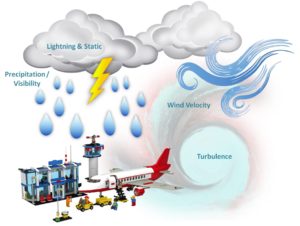Changing weather patterns triggered by the depletion of the ozone layer has a direct negative effect on many key sectors in Nigeria, according to the 2019 report of the Nigerian Meteorological Agency.
The climate agency said the situation was worrisome, and, if not checked, could have a direr impact on the economy and health of Nigerians.
The 2019 review of weather trends, which was contained in a document shared by NIMET at the Seasonal Rainfall Prediction, stated that weather features such as flooding and dust haze significantly affected flight operations and the entire transport sector.
Dust haze was observed all over the country reducing visibility to less than 500 metres. The coast and inland cities witnessed a reduction in horizontal visibility to about 200 to 900m due to early morning fog.
Flight operations were disrupted due to heavy downpour, severe thunderstorms and windstorms, which disrupted aviation activities. The disruptive effect of climate change continued to threaten the country’s aviation sector.
Are we contributing to the dangers of climate change? Certainly! A flight distance of 5,826 miles (9376.019km) emit nearly as much Greenhouse Gas a car would in a year. The aviation industry leads the pack in the league of emission in the transport sector.
Overall, the aviation industry accounts for 11 per cent of all transportation-related emissions in the United States and, according to some estimates, there are over 20,000 aircraft allover the world servicing over three billion people. It is estimated that by 2040, about 50,000 planes will fly the airways.
If Nigeria is really committed to the global efforts towards checkmating the effect of climate change, then keeping our planet’s temperature below the tipping point of 20C should be our priority.
Some 11,221,608 air travellers went through Nigeria airports in 2017, according to figures released by the Consumer Protection Directorate of the Nigerian Civil Aviation Authority. The 30 airlines on the international routes operated a total of 13,503 flights and carried 3,575,542 passengers during the period under review. Eight domestic airlines operated 48,319 flights and airlifted 7,646,600 passengers across the country. Thus, airlines on the domestic routes accounted for 68 per cent of the passenger traffic, while the international route recorded 32 per cent.
On average, a plane produces a little over 0.02 metric tonnes of carbon dioxide per mile. This,multiplied by the number of flights in Nigeria alone, is worrisome.
The most effective way to check climate change and its debilitating effect on the nation’s aviation sector is to fly less often. If everyone took fewer flights, airline companies wouldn’t burn as much jet fuel.
According to the World Bank, the average frequent traveller generated about 16.4mt of carbon dioxide in 2013 alone. Some calculations show that a round-trip flight from New York to San Francisco emits about 0.9mt CO2 per person.

The global average was about five tonnes of CO2 per person in 2013.
Commercial airlines have been using biofuels in some passenger flights since 2011, mixed with conventional petroleum-based fuels in varying amounts. The biofuels, which come from natural oils, seaweed and agricultural waste, can help reduce planet-warming emissions through aviation.
In 2016, United Airlines started using biofuels in all of its flights out of Los Angeles. The biofuel, made by a company called Altair Fuels, is estimated to cut at least 60 per cent of GHG emissions compared to regular jet fuel, according to United.
Other companies and the American government are working to develop alternative biofuels to use in the airline industry.
One wonders if Nigeria is taking steps towards switching to the use of biofuels just like the United States.


